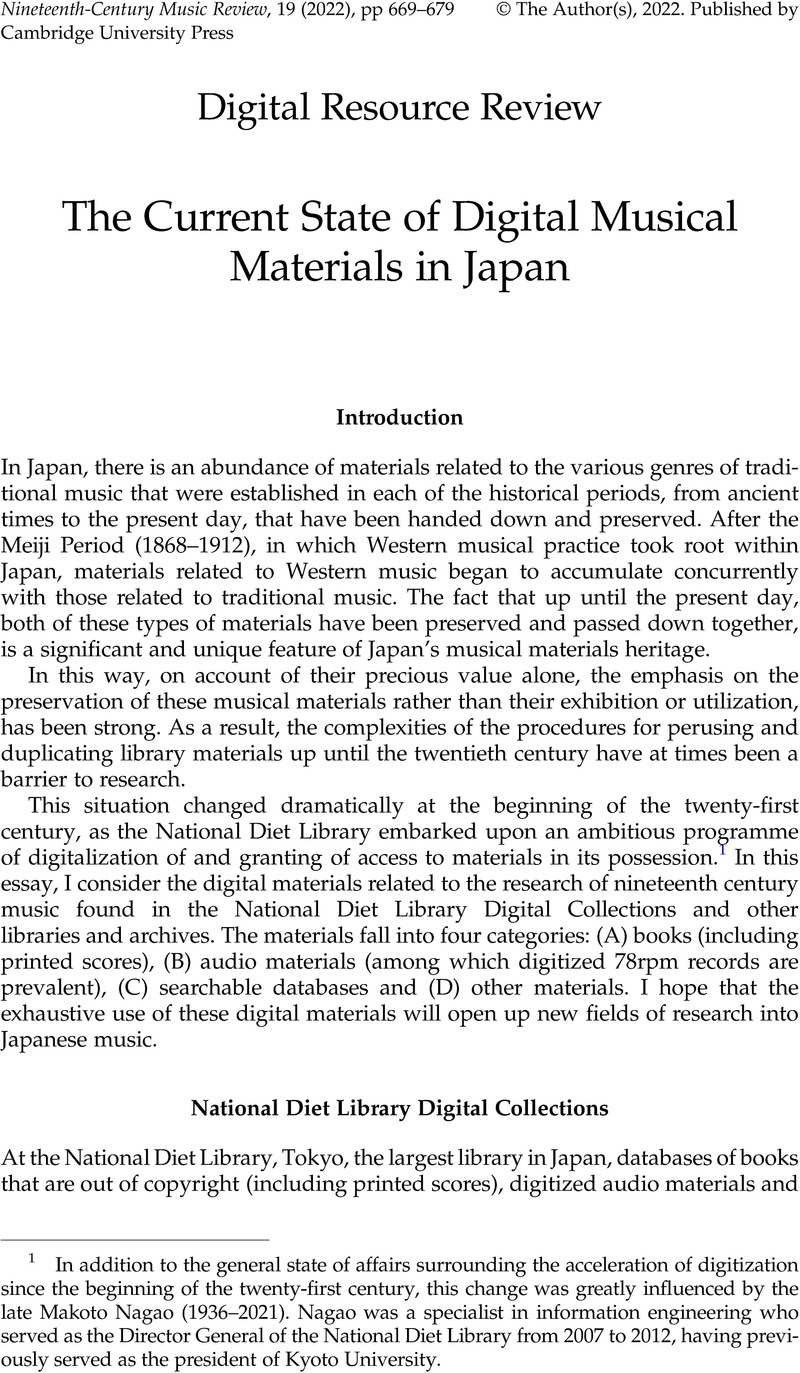Published online by Cambridge University Press: 05 May 2022

Translated by Stephen Ithel Duran
1 In addition to the general state of affairs surrounding the acceleration of digitization since the beginning of the twenty-first century, this change was greatly influenced by the late Makoto Nagao (1936–2021). Nagao was a specialist in information engineering who served as the Director General of the National Diet Library from 2007 to 2012, having previously served as the president of Kyoto University.
2 For more on the National Diet Library Digital collections, please see the site's ‘About’ page: https://dl.ndl.go.jp/en/intro.html. All websites discussed in this review were accessed in November 2021.
3 Items for which the copyright protection periods have yet to be verified may only be viewed (both within and outside of Japan) on the premises of those libraries participating in the National Diet Library's Digital Materials Transmission Service for Libraries. As of 1 October 2021, there are 1,315 participating libraries within Japan. The acceptance of foreign participation began in 2019, and the United States, Italy and Spain, each have a single participating library: https://dl.ndl.go.jp/en/soshin_librarylist.html.
4 For digitized books at the National Diet Library: https://dl.ndl.go.jp/?__lang=en.
5 The Nippon Decimal Classification (NDC) is the classification system most widely used at libraries in Japan.
6 For audio materials at the National Diet Library see https://rekion.dl.ndl.go.jp/.
7 The six organizations that formed the conference were the Japan Broadcasting Corporation (NHK), the Japanese Society for Rights of Authors, Composers and Publishers (JASRAC), the Japan Council of Performers Rights & Performing Arts (Geidankyō), the Japan Traditional Cultures Foundation, the Visual Industry Promotion Organization (VIPO) and the Recording Industry Association of Japan (RIAJ).
8 Streaming is offered mostly in libraries within Japan, but there are five participating libraries in the United States. Germany, France and Switzerland also each has a participating library (as of 4 October 2021); see https://dl.ndl.go.jp/ja/rekion_librarylist.html.
9 https://db.nichibun.ac.jp/pc1/ja/category/rokyoku.html. Rōkyoku is a narrative tradition established in the modern period that includes shamisen accompaniment. It gained mass popularity between the 1880s and the 1960s.
10 Kamigata Zashiki Uta is a genre of small-form shamisen music that was performed by kamigata (Kansai) geisha in red-light district tatami-room parties.
11 This facility is the descendant of the Japan Modern Music Foundation's Japan Modern Music Library, which was opened in 1987. The latter had its origins in the Tōyama Foundation for Music Archives which was founded in 1966 (and was renamed Tōyama Foundation for Music Library in 1969).
12 Here, modern-era Japan refers to the period from the 1860s to around 1945.
13 For the history and development of the Center for Asian Historical Records, see www.jacar.go.jp/about/outline.html.
14 For a summary of the materials offered, see www.jacar.go.jp/about/materials.html.
15 In addition to 20 participating Japanese universities, the Rekishiteki Tenseki NW Jigyō also coordinates with foreign universities and research institutions. For a detailed explanation of the database and a summary of its projects, please see the following link: www.nijl.ac.jp/pages/cijproject/en/plans.html.
16 Although I say ‘a few books’, as of June 2021 the number of images made publicly available exceeds 150,000, and this number is expected to increase as the digitization of images progresses.